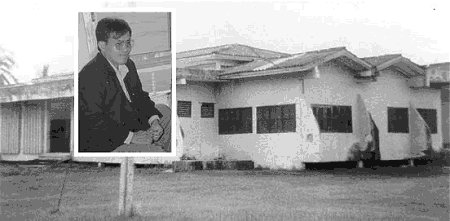|
|
|
SEAPAVAA Newsletter |
|
Country Update: LAOS Lao database to include film and video catalog details 
The Laos National Film Archive and Video Center ( LNFAVC) with Bounchao Phichit, Deputy Director of LNFAVC (inset) The Laos National Film Archive and Video Centre (LNFAVC) participated in the recent third annual conference of SEAPAVAA. The conference was also attended by delegates from Australia, Austria, Indonesia, Laos, Malaysia, New Zealand, Philippines, Thailand, United Kingdom, United States, and Vietnam. Laos was represented by Mr. Bounchao Phichit, Deputy Director of LNFAVC and Mr. Salieng Xiengvong, film archivist. The theme of the conference was "Emerging Audiovisual Heritage - Accessing the Voice and Vision of Southeast Asia and the Pacific". Participants discussed ways of making the film, television, and audio heritage of the region more accessible and more visible to the global marketplace, consistently to develop their skills at home and at training courses overseas. The conference adopted a statement of principles concerning public accessibility of their collections and reviewed strategies for better realizing this objective. A key strategy adopted in December 1997, is the development of a regional catalog database which will eventually be multi-lingual and encompass the major audiovisual collections of the participating countries. The project is being supported by the ASEAN Committee on Culture and Information (COCI), the Australian government (through the ASEAN-Australia forum), and the National Film and Sound Archive of Australia (NFSA). The database uses the NFSA-developed MAVIS software, which is also used by the American Library of Congress. As soon as it is linked to the internet, the Laos National Film and Video Center will be adding Lao film and video catalog details to the regional database, and accessing the information provided by other countries. SEAPAVAA President and Deputy Director of the NFSA, Mr. Ray Edmondson, visited Vientiane following the SEAPAVAA conference for discussions with his Laos colleagues. He spoke to the Vientiane Times about his impressions of developments since his first visit in 1991 when the film archive was in the process of being set up. "I am most impressed by what has been achieved in the last seven years. When the Archive began, it had building accommodation and a collection of film (stacked in piles on the floor) and not much else. "The collection had not been stored in a controlled environment and the film was suffering from `vinegar syndrome', a kind of degradation aggravated by heat and humidity, and therefore prevalent in tropical countries. Because the material had been assembled from various sources, it was not systematically organized, nor was all the materials identified. "Stage by stage the building has been remodelled, temperature and humidity controlled environment have been created, and the collection is being progressively documented, both from a technical-control and cataloguing viewpoint. A range of film and video technical equipment has been assembled. The staff are a committed group who have worked consistently to develop their skills at home and at training courses overseas. "Because of this work, it is now possible to work on making the Laos national collection accessible and this is happening increasingly - through telecasting, screenings on Archive premises, and screenings by a mobile projection units in locations outside Vientiane which have attracted huge audiences. "Of course there is more to be done. Audiovisual archiving is, by its nature, expensive and, in any country, needs are always greater than the available resources. Nor are the realities of the work well understood: most people assume that the survival of films and television programs happens automatically, and requires no more care than simply being left safely on a shelf - when the truth is exactly the opposite. "One of the objectives of SEAPAVAA is to help its members pool their resources and use them more effectively through cooperation. Another is to raise the profile of audiovisual archiving so that its needs and advantages are better understood by governments, the media industries and the general public. A third is to provide a professional forum for information exchange and skills development. "Rapidly changing technologies are providing some new answers to the problems of preservation, but also introducing new questions and uncertainties. One problem is the decreasing "shelf life" of current formats, like the VHS cassette or the CD. The lifespan of the tape and the disc cannot be predicted with certainty, but we can certainly predict that the technology itself will supersede long before its products have reached the end of their life. And then, how will you play back the images and sounds they contain?" Will SEAPAVAA meet in Laos? Currently planned, said Mr. Edmondson, are a technical workshop on "vinegar syndrome" in Hanoi later this year, and annual conferences in Malaysia (1999) and Singapore (2000). He felt SEAPAVAA members would be glad of a future opportunity to meet in Laos. As a parting comment, what were Mr. Edmondson's current impressions of Vientiane? "It's changed, hasn't it? There are plenty of new buildings, and a lot more traffic. But it's still green, unhurried and pleasant to walk around. I hope that's an aspect that never changes." Reprinted from Vientiane Times, April 3-6, 1998
|